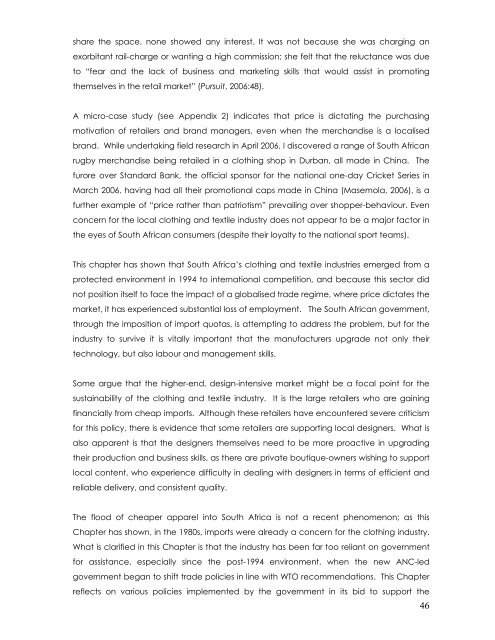You also want an ePaper? Increase the reach of your titles
YUMPU automatically turns print PDFs into web optimized ePapers that Google loves.
share the space, none showed any interest. It was not because she was charging an<br />
exorbitant rail-charge or wanting a high commission; she felt that the reluctance was due<br />
to “fear and the lack of business and marketing skills that would assist in promoting<br />
themselves in the retail market” (Pursuit, 2006:48).<br />
A micro-case study (see Appendix 2) indicates that price is dictating the purchasing<br />
motivation of retailers and brand managers, even when the merchandise is a localised<br />
brand. While undertaking field research in April 2006, I discovered a range of South African<br />
rugby merchandise being retailed in a clothing shop in Durban, all made in China. The<br />
furore over Standard Bank, the official sponsor for the national one-day Cricket Series in<br />
March 2006, having had all their promotional caps made in China (Masemola, 2006), is a<br />
further example of “price rather than patriotism” prevailing over shopper-behaviour. Even<br />
concern for the local clothing and textile industry does not appear to be a major factor in<br />
the eyes of South African consumers (despite their loyalty to the national sport teams).<br />
This chapter has shown that South Africa’s clothing and textile industries emerged from a<br />
protected environment in 1994 to international competition, and because this sector did<br />
not position itself to face the impact of a globalised trade regime, where price dictates the<br />
market, it has experienced substantial loss of employment. The South African government,<br />
through the imposition of import quotas, is attempting to address the problem, but for the<br />
industry to survive it is vitally important that the manufacturers upgrade not only their<br />
technology, but also labour and management skills.<br />
Some argue that the higher-end, design-intensive market might be a focal point for the<br />
sustainability of the clothing and textile industry. It is the large retailers who are gaining<br />
financially from cheap imports. Although these retailers have encountered severe criticism<br />
for this policy, there is evidence that some retailers are supporting local designers. What is<br />
also apparent is that the designers themselves need to be more proactive in upgrading<br />
their production and business skills, as there are private boutique-owners wishing to support<br />
local content, who experience difficulty in dealing with designers in terms of efficient and<br />
reliable delivery, and consistent quality.<br />
The flood of cheaper apparel into South Africa is not a recent phenomenon; as this<br />
Chapter has shown, in the 1980s, imports were already a concern for the clothing industry.<br />
What is clarified in this Chapter is that the industry has been far too reliant on government<br />
for assistance, especially since the post-1994 environment, when the new ANC-led<br />
government began to shift trade policies in line with WTO recommendations. This Chapter<br />
reflects on various policies implemented by the government in its bid to support the<br />
46
















